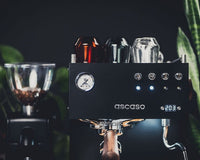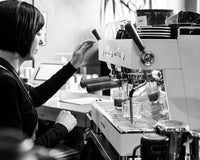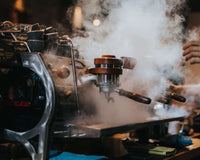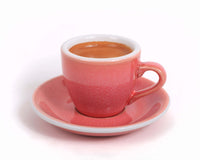It takes more than smiling baristas and well-roasted coffee to make a café great. The brewing equipment you use plays an integral part in the quality and efficiency of your coffee, so choosing the right equipment is important. Whether you’re completely outfitting a new shop or retiring some long-used gear, Espresso Parts has the experience and tools to help you make the right decisions.
What to Consider When Equipping Your New Cafe
1. Investing in a Quality Espresso Machine

An espresso machine isn’t just a way to quickly make coffee — it’s the heart of any cafe! With so many manufacturers and models to choose from, finding the right one can be a daunting task. Whether you’re a full-service coffee shop, an all-day café, or a retailer looking to expand your offerings, here are a few things to consider before purchasing an espresso machine.
Select a Machine that Matches Your Menu Offerings
Selecting a machine that’s right for your menu is incredibly important. Will you offer milk-heavy beverages like 16 or 20-ounce lattes? You’ll need a machine with a larger steam boiler to keep up with all of the steaming.
Consider your Demographic
Who are your customers? While the easy answer is “coffee-lovers,” you must take a look at how demographics impact your menu. If your cafe is located on or near a college campus, flavored lattes, blended drinks, and cold brew will be some of your best sellers. In an office building or business district, drip coffee will be popular since it’s a quick option for customers on the go.
Know the Volume of Drinks You’ll be Making
How many drinks are you making per day? How many drinks do you want to make per day? While both questions are important, the latter is crucial in determining which espresso machine is right for you. While a single or two group machine might work for your current volume, it may limit output as your business grows. If you expect to grow to high volumes, it may be good to consider a semiautomatic or auto-volumetric machine over a manual machine.
2. Selecting the Right Espresso Grinder
Espresso efficiency comes down to speed, and with grind times ranging from 4 to 20 seconds for a double shot, your espresso grinder can make or break output behind the bar. Here are a few things to think about when determining which grinder or grinders are right for your bar.
Understand Your Variety of Coffee Offerings
Coffee varies greatly between origins, varietals, and roasters. It’s important to recognize that not all coffee should be ground the same, and different methods of preparation require different consistencies and volumes of ground coffee. We recommend having one dedicated grinder per coffee. If you have a decaf espresso option, we suggest getting a separate grinder that can also be used as a backup if your main grinder is down. Having multiple grinders allows you to dial in each grinder to the specific coffee being used. This creates a better shot of espresso, less waste, and shorter preparation times.
Know How Busy Your Bar Will Be
How busy is your espresso bar? If espresso makes up the majority of your business, investing in a grinder with a large hopper, volumetric controls, and a portafilter cradle is a wise choice. Many grinders boast features that allow a barista to grind a shot with just the touch of a button, allowing them to multitask while the grinder does its job. Grinder speed is directly correlated to burr size and motor speed, so pay attention to these features when comparing models.
3. Determining if Batch Brewing is Right for You
Having large batches of drip coffee can be very beneficial for a busy cafe, but is it right for you? Let’s explore some variables that can help determine whether or not a batch brewing system is right for your cafe.
Know the Volume of Coffee You Plan to Sell
How much drip coffee will you sell? If you are in a high-traffic commuter area, odds are many of your customers will order drip coffee as a means to get in and out as quickly as possible. If you’re located in a small town or quiet area, it may not make sense to brew large batches of coffee, so a brewing system with half or quarter-batch capability may be a good option. Will you offer different drip options like single-origin or decaf? A twin brewer can give the output you need to ensure you never run out of coffee.
Understand if Batch Brewing Fits into the Bar Flow
Where does batch brew fit within your bar flow? Many cafes choose to task the cashier/point of sale person with batch preparation and serving. This allows customers who order drip coffee to receive their beverage immediately after ordering and allows the barista to focus on espresso. If you’re low on space, a single brewer with multiple thermopots can allow you to quickly brew and keep multiple batches while saving on counter space. If you plan on offering a self-serve drip station, we recommend having twice as many thermopots as coffee offerings so there can always be a backup brewing or ready.
Consider a Batch Brew Grinder for High-Volume
When you’re brewing batches of coffee for your high-volume morning rush, you’ll need a grinder that can grind large quantities of beans with speed and consistency. Will you be brewing batch coffee all day long? It may be a good idea to find a grinder with a large hopper to limit the number of refills needed. Serving a variety of coffee options? Look for a grinder with easily accessible grind settings since you’ll be adjusting between each roast.
4. Creating a Memorable Experience with Manual Brewing
Manual brew methods like pour-over and immersion are great ways to give customers a memorable experience and further their coffee education. They also allow you to offer a premium product at a higher price point. While not all cafes are suited for manual brewing, here are some reasons why it may be advantageous for you.
If Your Customers Love Coffee, Manual Brewing is Key
If you find yourself engaging with customers about coffee origins, varieties, and brew methods, then manual brewing may be a great way to engage them on a deeper level.
Consider Manual Brewing if You Have Space
Manual brewing requires a dedicated prep area and additional gear like drippers, carafes, and kettles. If your cafe is already tight on space, manual brewing may cause unnecessary stress.
Retail? Manual Brewing Can Be a Perfect Combination
Manual brewing and retail go hand-in-hand. Why? When customers experience manual brew methods, it encourages them to explore the world of coffee at home. Offering manual brew gear like filters, drippers, and grinders can provide an additional stream of revenue and strengthen relationships with customers.
5. Getting all the Bar Tools and Wares You’ll Need
No cafe is complete without coffee preparation essentials and proper cleaning products. Here are five things you should never go without.
Cleaning Supplies
A clean cafe is a good cafe! Coffee equipment must be cleaned differently than typical household appliances, so make sure to use the proper cleaning supplies to avoid damage.
Pitcher Rinser
A high-powered pitcher rinser will quickly rinse shot glasses and pitchers between uses while saving time and water. No more trips back and forth to the sink - install it right where you need it.
Barista Basics
Shot glasses, tamping mats, knock boxes, rags, and more can be found in our Barista Basics collection. We’ve drawn on our many years of industry experience to design and manufacture our own line of high-quality pitchers and tampers.
Scales
From preparing batch brew to dosing espresso, measuring coffee by weight is crucial for consistency. Find a quality scale that’s water-resistant and can measure a range of weights. If you’re using scales for espresso and manual brew, we recommend finding one with a built-in timer.
Tamp
Having the proper tamper is essential for espresso extraction. When you find one you like, buy two! Always have a backup in case of loss or damage.
6. Knowing Your Cleaning and Maintenance Routine
The best coffee is made with clean equipment, and commercial equipment has different needs than the appliances on your kitchen counter. Make sure to only use manufacturer-recommended cleaning products, and hire equipment-certified technicians for repairs and scheduled maintenance. Consider these things when purchasing cleaning products and planning operations.
Establish a Schedule
Whether it’s hourly like espresso filter screens, daily like thermopots, or weekly like equipment surfaces, the best way to keep track of what has been cleaned is by establishing a schedule that your employees can easily follow. Shift checklists are a great way to delegate tasks based on time of day and cafe volume. Mid-morning is probably not the best time to dump and clean batch brew thermopots, so save that for the afternoon baristas to do after closing.
Perform Preventative Maintenance
Keeping your equipment maintained with parts and service keeps it running smoothly and prevents further damage. Things like grouphead gaskets, grinder burrs, and hose fittings are all things that wear out over time. They are inexpensive and easy to replace but can lead to more expensive issues if not addressed properly.
Yearly Checkups
For larger equipment like espresso machines and batch brewers, it’s a good idea to schedule yearly checkups with a certified technician. This allows for a deeper understanding of pumps, heating elements, and electrical systems and can help prevent small issues from getting worse over time.
7. Considering Branded & Customized Gear
Nothing makes a cafe feel more cohesive than intentional branding. Think about it - what if your logo, menu, and website perfectly tied into your cups, espresso machine, and bar accessories?
Customizing your Espresso Machine
Your espresso machine speaks to customers as soon as they walk through the door, so let it tell a great story! EP Custom Shop’s team of craftsmen can masterfully transform your machine into a work of art. Custom finishes, metal plating, wood accents, glass body panels, interior lighting, logos - the sky is the limit with EP Custom Shop.
Personalizing Cups and Ceramic
When your satisfied customer snaps a picture of her artfully-poured latte, wouldn’t it be cool if your logo was right there on the cup? With custom logos and colors, your cups can be more than cups - make them a part of your brand, and customize now.
Whew. There’s a lot to consider, but that’s where we come in! Espresso Parts has been helping cafes, restaurants, and industry professionals make educated decisions for almost thirty years. Do you have specific questions about equipping your cafe? Contact us today.






